Is less more, or is more more when it comes to teaching writing?
When teaching writing, sometimes the most helpful thing is knowing when less is more and when more is more. Writing can be one of the hardest subjects to teach. Often, students don’t want to do it, and teachers don’t want to read it. And for those teachers who truly appreciate the beauty of a finely crafted letter, essay, or story, reading student work can sometimes make you cringe.
A common defense mechanism is to avoid that which is unpleasant, and short-change the time we spend teaching writing, or even assign writing rather than teach writing. We know that avoidance only perpetuates the problem, so we must put on our big girl (or guy) pants, and get the job done!
Thankfully, there are many ways we can ease the pain of teaching writing! Without further adieu, brave souls, here are six ways to survive teaching writing:
6) Practice, Practice, Practice & Don’t grade it all!
Just as musicians and athletes practice for performances and games, students must practice writing; not every piece will be fit for publishing! You can’t grade every piece of writing, nor should you! Some practice should be just that – practice. One approach to this is to give students a new prompt on which to write an outline and/or rough draft each day for a week. The following week, have them select one piece to edit and revise into a final draft.
The choice gives students a chance to evaluate their own writing to select their best work, and it creates more excitement and buy-in for creating a final draft. When they turn in their final work, have them attach all five prompt responses to evidence their practice, but you will read and respond only to the final draft.
Of course, the timing doesn’t need to be this rigid. I usually spread this out, aiming for one “major” writing assignment per month. We also make time for teaching writing, focused skills practice, and smaller activities and assignments.
5) You are NOT an editor
No one likes to receive a paper back drowning in a sea of red ink; more importantly, have you ever known a student to be motivated by your ability to point out his/her every error? I’m not suggesting that grammar, usage and mechanics aren’t important; they certainly are! I’m suggesting that you prioritize to save time and be more effective in grading papers.
I usually correct no more than three errors per paragraph, and I focus in one of two directions:
- Correct the more egregious errors first, the ones that make it difficult to read and understand the student’s work. For example, missing capital letters and end punctuation are usually more important than missing commas.
- Correct errors on the skills you have been teaching in class. For example, if you’ve been practicing using commas in compound sentences, be sure to correct these errors.
I share my approach with students and parents at the beginning of the year so they understand what to expect. Most are very receptive to this idea.
Remember, students are more likely to pay attention to the things you mark if there isn’t an overwhelming amount of things marked. Help your students; help yourself. Prioritize!
4) Spend less time grading writing
Hallelujah, sign me up! Who doesn’t want to spend less time grading?! The problem is, we want to make sure we are doing right by our students. Grading in less time can be done guilt-free with the right tools.
Tool #1: Rubrics
Rubrics are essential for helping students understand your expectations and for both you and your students to identify areas of strength and weakness. An incredible source for pre-made/editable rubrics is Rubistar. I can’t recommend it highly enough!
Tool #2: Printed labels
You will often find yourself making the same or similar comments on students’ papers. Before I started using labels, the first paper I graded looked like this, in my finest penmanship:
“All sentences must have end punctuation such as a period (.), question mark (?), or exclamation point (!).”
While the last student received this, hastily scrawled & barely legible:
“End marks – (.), (?), (!)”
Start a collection of common comments on return address labels. Students will receive consistent, quality feedback, and you will receive a writing hand free from cramps! Save your handwritten comments for compliments.
Tool #3: Timer
Decide on an amount of time to devote to each student’s paper. Depending on the length of the piece, this might be 3-5 minutes. If you use a rubric, pre-printed labels, and aren’t acting like an editor, this should be enough time. At first the timing will be difficult. The timer will ring before you are ready, but soon you will train yourself to grade in a constrained time. Providing faster, focused feedback is better for students than providing a mountain of comments and feedback once or twice a year.
3) Find or create irresistible writing prompts
If you want your students to generate creative ideas, you need to give them something to work with! Find fresh prompts to spark the imagination whenever possible.
One excellent source for prompts is Reddit. On reddit.com, there is a writing sub-reddit with user-generated content. I’ve pulled a few examples of my favorites below. For good reason, Reddit is likely blocked at your school site. The site contains some school-inappropriate content, so don’t send students there and preview anything you intend to share with students first!
One fun way to use the writing sub-reddit is to print some of the user responses for students to edit, revise, or comment upon. Remember, you must read carefully, as some of the responses won’t be appropriate for students.
One more thing about assigning prompts: it’s important to recognize differences in students’ processes. Some students will want to dive in and write, others will want to discuss ideas with peers first, while some don’t write well in a public setting at all. As much as possible, be flexible in your approach to account for these differences.
Reddit Prompts:
- The zombie apocalypse breaks out. You remain safe in isolation for 30+ years. Someone finds you and informs you the zombie apocalypse ended 20 years ago.
- A couple is having their first child, when they admit to each other that they both promised their first born to a witch. It’s two different witches
- Humanity has finally cured it’s need to sleep with a very cheap, easily manufactured pill. It only took 5 years for the side effects to become apparent.
- After years of defending your city against your arch nemesis, you take a day off and turn on the News only to find out that the people consider you to be the evil one.
- Tired of the constant explosions of fireworks, you look outside your window to see what’s going on. But you realize that your backyard now looks like a battlefield. And the Revolutionary War is happening right outside your house.
- Describe a bad day from the perspective of people in 3 different parts of the world.
- Your habit of catching and releasing spiders you find in your home pays off one day.
- You switch your personality with your dog
- Write me a story in exactly 7 sentences.
- The year is 2060 and the world is in chaos due to a housing shortage. One man is tasked with fixing this crisis. His name is Bob and he is a Builder.
- One of the Rice Krispies triplets is missing. Snap and Crackle search for their brother.
2) Teach the elements of writing
There’s just no way around it: If you want to students to be great writers, you must teach them to be great writers. Writing isn’t mystical; it’s actually simple to teach if you break it down into manageable chunks. If writing isn’t your forte, or you just want to save time, get some help for your journey. The Internet is full of resources!
 |
|
|
1) LOVE writing!
Model enthusiasm and love of great writing! Admire the craft! Share your favorite quotes, opening sentences, metaphors, song lyrics, etc., and provide students space and time to do the same. You must also remember to focus on the good in their writing. No matter what, when you return comments on student work, there should always be a compliment whether it’s a character’s personality, a great introduction, beautiful metaphor, perfectly-used word, a surprise ending, nice penmanship…whatever!
Writing is a vulnerable process, so be sure you honor your students’ trust in you by encouraging their progress.
Remember, love and appreciation of great writing is contagious! It might very well be the best gift you give your students!
Happy writing!
Also check out:
PIN ME










